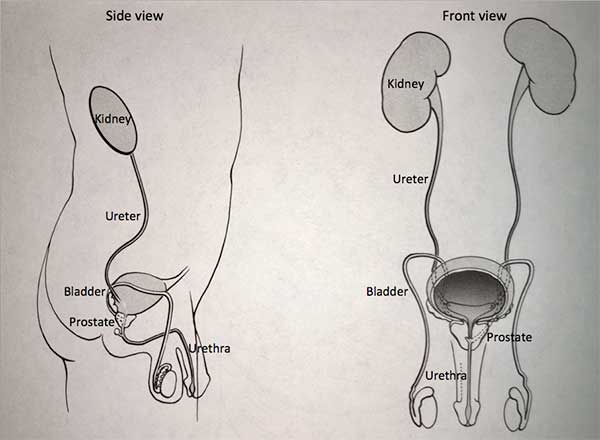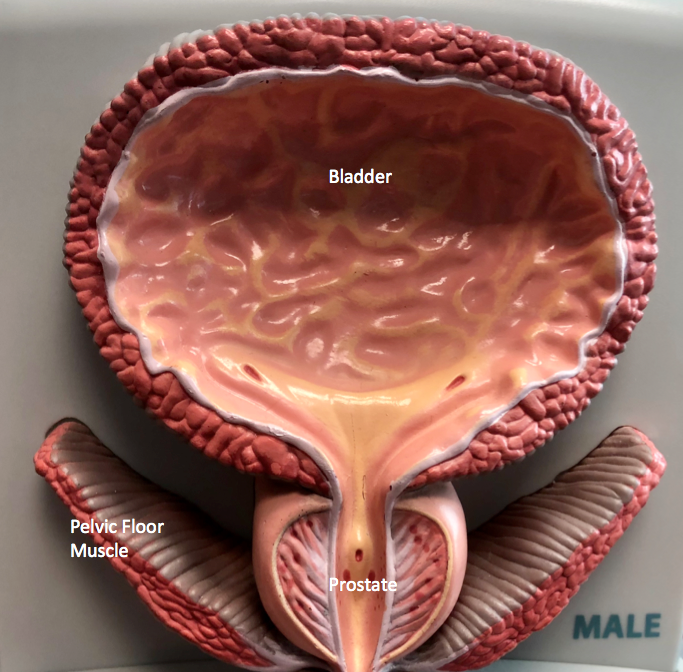Male Urinary Incontinence
Urinary incontinence is a condition that is common in men.
What is incontinence?
Incontinence is a term used to describe the involuntary loss of urine. To understand incontinence, it helps to understand how the urinary system works. Urine is made in the kidneys. The kidneys, which sit high in the back under the rib cage, filter the blood and extract excess waste products and fluid to form the urine. The urine, once made in the kidneys, travels down a tube on each side called the ureter until it reaches the bladder. The bladder stores urine until full and then it empties urine to the outside through the urethra.

What are the two types of incontinence?
There are two common types of incontinence – stress incontinence and urge incontinence.
Stress incontinence occurs when there is a sudden increase in pressure to the bladder, such as that which occurs with coughing, sneezing, running, dancing, or changing from sitting to standing position. This sudden increase in pressure, known as a “stress” to the bladder, causes urine to leak from the bladder through the urethra. In men, stress incontinence may develop as a result of prostate surgery.
Urge incontinence occurs when there is the sudden sense of the need to urinate but the inability to postpone voiding to reach the bathroom in time. In that circumstance, the bladder begins to contract on its own such that urine is lost involuntarily.

Urge incontinence occurs because the bladder involuntarily contracts on its own to push urine to the outside. If the bladder had its way, it would never fill with urine and would contract as soon as urine reached the bladder from the kidney. However, the bladder is prevented from going on its own by a reflex. When the reflex does not work properly, the bladder has an “uninhibited contraction” and goes on its own. Patient who have urge incontinence say they are plagued with situations where they may reach the door of their house and feel an intense need to go, but before they can get the door unlocked and reach the bathroom, they begin to get wet.
What is done to evaluate incontinence?
An office exam is the first step. In addition, a urodynamic study may be done. Urodynamics refers to tests done to measure the capacity of the bladder and the pressures at which urinary leakage takes place. These tests are done by placing a small catheter into the bladder. The bladder is then filled to evaluate its storage ability and to identify the pressure at which leakage takes place.
What is done to treat stress incontinence?
Stress incontinence is managed with a stepwise approach. Kegel exercises are usually tried as part of the initial management. These are done by squeezing the muscles of the pelvic floor for 5-10 seconds at a time for 30-40 times a day. The “right” muscles to exercise are identified by contracting the muscle during urination that stops the flow of urine. Once that muscle is identified, it should be exercised 30-40 times during the day when not urinating. For example, it can be done while riding in a car, sitting in a chair, or standing in a store. The muscle does not need to be squeezed during urination on a regular basis. Kegel exercises lessen stress incontinence in about half of patients, but the effect may not be noticeable until after 3-4 months of carrying out these exercises.
Other non-surgical methods occasionally help with stress incontinence. Pelvic floor stimulation and biofeedback may offer some benefit.
If the above methods are not providing benefit and if the symptoms are troublesome enough that a patient wants something done, surgical techniques are available to address stress urinary incontinence. In some patients with stress urinary incontinence, leakage develops due to failure of the urethra to close tightly. In this case, collagen can be injected underneath the surface of the urethra to create a better seal. This technique is carried out on an outpatient basis with minimal sedation. Many patients notice a favorable initial improvement. However, the collagen becomes reabsorbed in most and the results provide short-term help only.
A device called an artificial urinary sphincter may be placed around the urethra which may lead to resolution of urinary leakage.
What is done to treat urge incontinence?
A variety of medications are available to manage urge incontinence and include Detrol, Ditropan, Enablex, Myrbetriq, Oxytrol, VESIcare, and Sanctura. These medications suppress “uninhibited bladder contractions” and lessen the likelihood of the bladder going on its own.
Some patients have a mix of both stress and urge incontinence and a combination of the above treatments may be used.
In summary, incontinence is a common problem. With appropriate evaluation and treatment, many patients can be helped.
Print PageContact us to request an appointment or ask a question. We're here for you.




